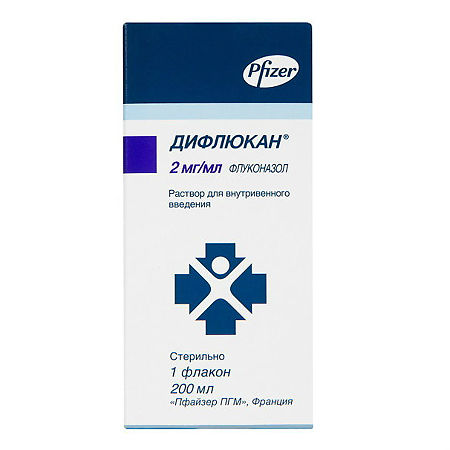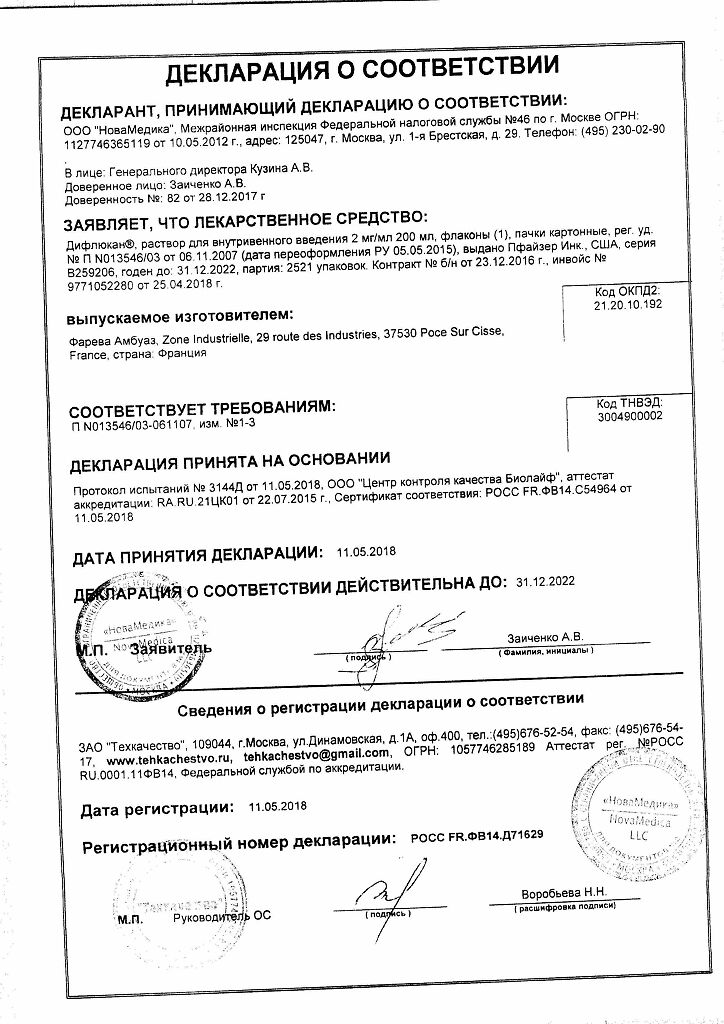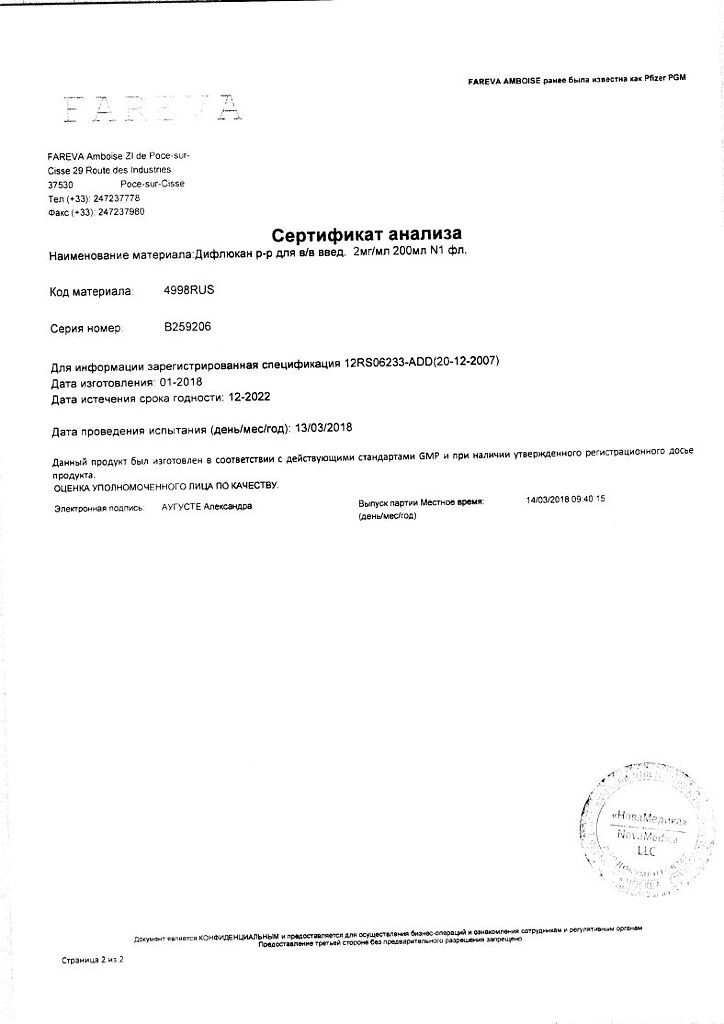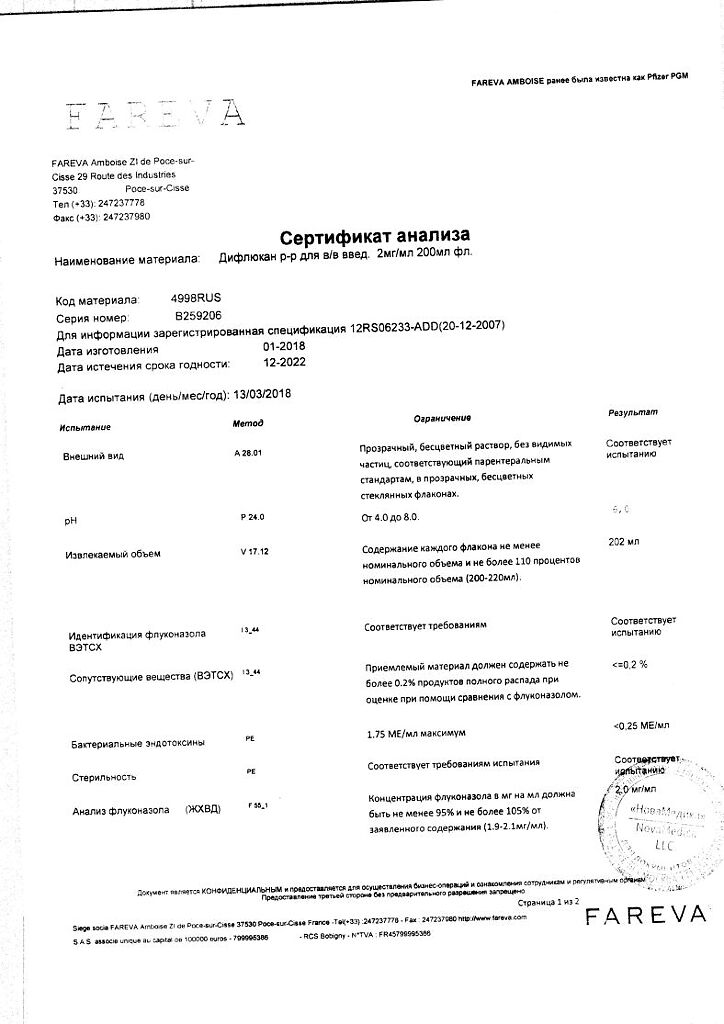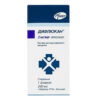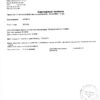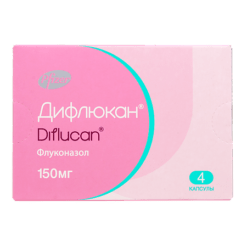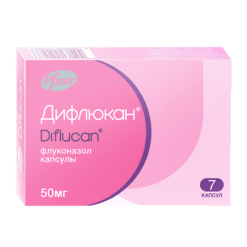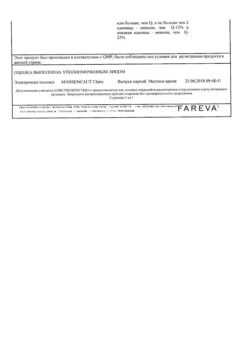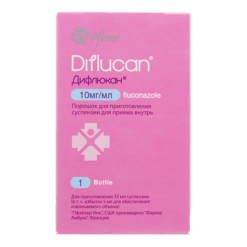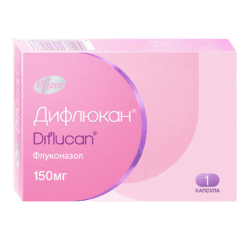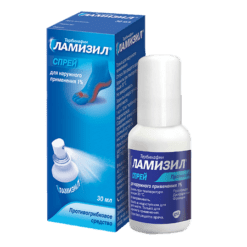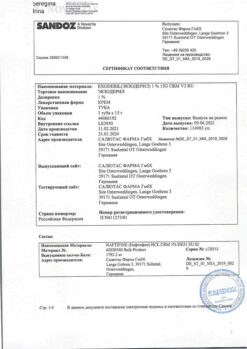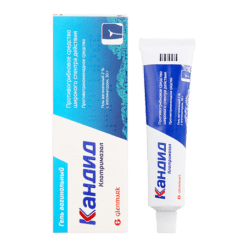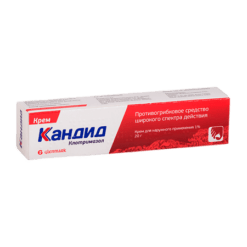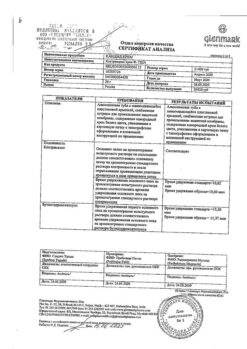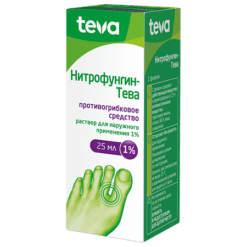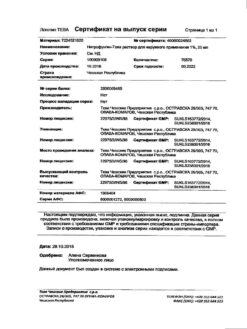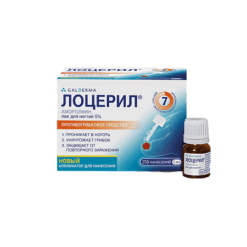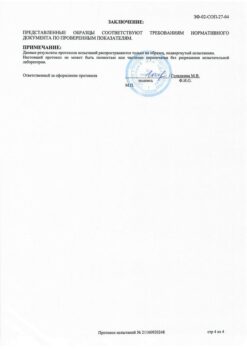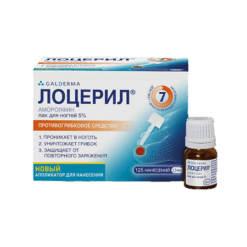No products in the cart.
Diflucan, 2 mg/ml 200 ml
€1.00
Out of stock
(E-mail when Stock is available)
Description
Pharmacological group
The antifungal drug of the triazole series is a potent selective inhibitor of sterol synthesis in the fungal cell.
Pharmacological action
Fluconazole activity has been shown in vitro and in clinical infections against most of the following microorganisms: Candida alhicans, Candida glabrata (many strains are moderately sensitive), Candida parapsilosis, Candida tropicalis, Cryptococcus neoformans.
In vitro activity of fluconazole against the following microorganisms has been shown, but the clinical significance is unknown: Candida dubliniensis, Candida guilliermondii, Candida kefyr, Candida lusitaniae.
Pharmacodynamics
Fluconazole showed activity in various models of fungal infections in animals when administered orally and by IV administration. The activity of the drug was demonstrated in opportunistic mycoses, including those caused by Candida spp. (including generalized candidiasis in immunocompromised animals), Cryptococcus neoformans (including intracranial infections), Microsporum spp. and Trychoptyton spp. Fluconazole activity has also been established in models of endemic mycoses in animals, including infections caused by Blastomyces dermatitidis, Coccidioides immitis (including intracranial infections) and Histoplasma capsulatum in animals with normal and with reduced immunity.
Fluconazole has high specificity against cytochrome P450-dependent fungal enzymes. Fluconazole therapy at a dose of 50 mg/day for up to 28 days has no effect on plasma testosterone concentrations in men or steroid concentrations in women of childbearing age. Fluconazole at a dose of 200-400 mg/day had no clinically significant effect on endogenous steroid levels and their response to ACTH stimulation in healthy male volunteers.
Mechanisms of resistance to fluconazole
Resistance to fluconazole can develop in the following cases: a qualitative or quantitative change in the enzyme that targets fluconazole (lanosterol 14-α-demethylase), reduced access to target fluconazole, or a combination of these mechanisms.
Point mutations in the ERG11 gene, which encodes the target enzyme, lead to target alteration and decreased affinity for azoles. Increased expression of the ERG11 gene leads to the production of high concentrations of the target enzyme, which creates a need to increase fluconazole concentrations in the intracellular fluid to inhibit all enzyme molecules in the cell.
The second significant mechanism of resistance is the active excretion of fluconazole from the intracellular space through the activation of two types of transporters involved in the active excretion (efflux) of drugs from the fungal cell. These transporters include the main mediator encoded by the MDR (multiple drug resistance) genes and the ATP-binding cassette transporter superfamily encoded by the CDR (resistance genes of Candida spp. fungi to azole antimycotics) genes.
Hyperexpression of the MDR gene leads to resistance to fluconazole, while hyperexpression of CDR genes can lead to resistance to various azoles.
Resistance to Candida glabrata is usually mediated by CDR gene overexpression, which leads to resistance to many azoles. For those strains in which the MIC is defined as intermediate (16-32 µg/ml), maximum doses of fluconazole are recommended.
Candida krusei should be considered a pathogen resistant to fluconazole. The mechanism of resistance is associated with reduced sensitivity of the target enzyme to the inhibitory effects of fluconazole.
Pharmacokinetics
The pharmacokinetics of fluconazole are similar when administered by injection and when taken orally.
Eabsorption
Fluconazole is well absorbed after oral administration, its plasma levels (and overall bioavailability) exceed 90% of plasma levels of fluconazole when administered by IV. Simultaneous food intake has no effect on absorption when administered orally. Cmax is reached 0.5-1.5 h after fluconazole administration on an empty stomach.
The plasma concentration is proportional to the dose.
Distribution
90% Css is reached by day 4-5 after initiation of therapy (when taken multiple times daily).
The administration of a shock dose (on day 1), 2 times the average daily dose, achieves Css 90% by day 2.
Vd approaches total body water content. Binding to plasma proteins is low (11-12%).
Fluconazole penetrates well into all body fluids. Fluconazole levels in saliva and sputum are similar to its concentrations in blood plasma.
In patients with fungal meningitis, fluconazole levels in the cerebrospinal fluid are about 80% of its plasma levels.
In the stratum corneum, epidermis, dermis and sweat fluid, high concentrations are reached that exceed serum levels. Fluconazole accumulates in the stratum corneum. When administered at a dose of 50 mg once daily, fluconazole concentrations were 73 µg/g after 12 days and only 5.8 µg/g after 7 days of discontinuation of treatment. When administered at a dose of 150 mg once/week, fluconazole concentrations in the stratum corneum were 23.4 µg/g on day 7 and 7 days after the second dose were 7.1 µg/g.
The concentration of fluconazole in the nails after 4 months of use at a dose of 150 mg once/week was 4.05 µg/g in healthy nails and 1.8 µg/g in affected nails; 6 months after completion of therapy, fluconazole was still detectable in the nails.
When comparing saliva and plasma concentrations after a single 100-mg dose of fluconazole in capsule form and oral suspension (rinsing and retained in the mouth for 2 min and swallowing), it was found that Cmax of fluconazole in saliva after suspension administration was observed after 5 min and 182 times the Cmax in saliva after capsule administration (reached after 4 h). After approximately 4 h, fluconazole concentrations in saliva were similar. The mean AUC0-96 in saliva was significantly higher when taking the suspension than when taking the capsule. No significant differences in salivary excretion rates or plasma pharmacokinetics were found when fluconazole was administered as two release forms.
Metabolism and excretion
Fluconazole is excreted primarily by the kidneys; approximately 80% of the administered dose is found unchanged in the urine. Fluconazole clearance is proportional to CK. No circulating metabolites have been detected.
The T1/2 from plasma is about 30 h. Prolonged T1/2 from plasma allows fluconazole to be taken once for vaginal candidiasis and once/day or once/week for other indications.
Pharmacokinetics in Special Clinical Cases
Table. Pharmacokinetic parameters of fluconazole in children
| Age | Dose | T1/2 (h) | AUC (µg×h/mL) | ||
| 11 days-11 months | Once w/v 3 mg/kg | 23 | 110.1 | ||
| 9 months-13 years old | once oral 2 mg/kg | 25.0 | 94.7 | ||
| once oral 8 mg/kg | 19.5 | 362.5 | |||
| 5-15 years old | repeatedly w/v 2 mg/kg | 17.4* | 67.4* | ||
| repeatedly w/v 4 mg/kg | 15.2* | 139.1* | |||
| repeatedly w/v 8 mg/kg | 17.6* | 196.1* | |||
| Mean age 7 years | repeatedly oral 3 mg/kg | 15.5 | 41.6 |
* is the rate noted on the last day.
In premature infants (approximately 28 weeks of development), fluconazole was administered by IV at a dose of 6 mg/kg every 3rd day until a maximum of 5 doses were administered while children remained in the OIT. The mean T1/2 was 74 h (range 44-185 h) on day 1, with decreases on day 7 averaging 53 h (range 30-131 h) and on day 13 averaging 47 h (range 27-68 h).
The AUC values were 271 µg×h/mL (range 173-385 µg×h/mL) on day 1, then increased to 490 µg×h/mL (range 292-734 µg×h/mL) on day 7 and decreased to an average of 360 µg×h/mL (range 167-566 µg×h/mL) by day 13.
The Vd was 1183 ml/kg (range 1070-1470 ml/kg) on day 1, then increased to an average of 1184 ml/kg (range 510-2130 ml/kg) on day 7 and to 1328 ml/kg (range 1040-1680 ml/kg) on day 13.
In elderly patients (65 years and older), a single oral dose of fluconazole 50 mg (in some cases with simultaneous use of a diuretic) found that Cmax was reached 1.3 h after administration and was 1.54 mcg/mL, mean AUC values 76.4±20.3 µg×h/mL, and the mean T1/2 was 46.2 h.
The values of these pharmacokinetic parameters are higher than in younger patients. Concomitant use of diuretics did not cause significant changes in AUC and Cmax. CK (74 ml/min), the percentage of drug excreted unchanged in the urine (0-24 h, 22%) and the renal clearance of fluconazole (0.124 ml/min/kg) were lower in older patients compared to younger patients. The higher values of pharmacokinetic parameters in elderly patients taking fluconazole are probably related to the reduced renal function characteristic of older age.
Indications
Indications
Diflucan is used in adults and children:
cryptococcosis, including cryptococcal meningitis and infections of other locations (for example, lungs, skin), incl. in patients with a normal immune response and in patients with AIDS, organ transplant recipients and patients with other forms of immunodeficiency; maintenance therapy to prevent relapses of cryptococcosis in patients with AIDS;
generalized candidiasis, including candidemia, disseminated candidiasis and other forms of invasive candidiasis, such as infections of the peritoneum, endocardium, eyes, respiratory and urinary tract, incl. in patients with malignant tumors who are in the ICU and receiving cytotoxic or immunosuppressive drugs, as well as in patients with other factors predisposing to the development of candidiasis;
candidiasis of the mucous membranes, including the mucous membranes of the oral cavity and pharynx, esophagus, non-invasive bronchopulmonary infections, candiduria, mucocutaneous and chronic atrophic candidiasis of the oral cavity (associated with wearing dentures), incl. in patients with normal and suppressed immune function; prevention of relapse of oropharyngeal candidiasis in patients with AIDS;
genital candidiasis; acute or recurrent vaginal candidiasis; prevention to reduce the frequency of relapses of vaginal candidiasis (3 or more episodes per year); candidal balanitis;
prevention of fungal infections in patients with malignant tumors who are predisposed to the development of such infections as a result of cytotoxic chemotherapy or radiation therapy;
mycoses of the skin, including mycoses of the feet, body, groin area, pityriasis versicolor, onychomycosis and skin candidal infections;
deep endemic mycoses in patients with normal immunity, coccidioidomycosis, paracoccidioidomycosis, sporotrichosis and histoplasmosis.
Pharmacological effect
Pharmacological effect
Clinical and pharmacological group
An antifungal drug of the triazole series, it is a powerful selective inhibitor of sterol synthesis in fungal cells.
Pharmacological action
Fluconazole has been shown to be active in vitro and in clinical infections against most of the following microorganisms: Candida alhicans, Candida glabrata (many strains are moderately sensitive), Candida parapsilosis, Candida tropicalis, Cryptococcus neoformans.
Fluconazole has been shown to be active in vitro against the following microorganisms, but its clinical significance is unknown: Candida dubliniensis, Candida guilliermondii, Candida kefyr, Candida lusitaniae.
Pharmacodynamics
When administered orally and administered intravenously, fluconazole showed activity in various models of fungal infections in animals. The activity of the drug in opportunistic mycoses has been demonstrated, incl. caused by Candida spp. (including generalized candidiasis in immunocompromised animals), Cryptococcus neoformans (including intracranial infections), Microsporum spp. and Trychoptyton spp. The activity of fluconazole has also been established in models of endemic mycoses in animals, including infections caused by Blastomyces dermatitidis, Coccidioides immitis (including intracranial infections) and Histoplasma capsulatum in animals with normal and reduced immunity.
Fluconazole has high specificity for fungal enzymes dependent on cytochrome P450. Treatment with fluconazole 50 mg/day for up to 28 days does not affect plasma testosterone concentrations in men or steroid concentrations in women of childbearing age. Fluconazole at a dose of 200-400 mg/day did not have a clinically significant effect on the levels of endogenous steroids and their response to ACTH stimulation in healthy male volunteers.
Mechanisms of development of resistance to fluconazole
Resistance to fluconazole can develop in the following cases: a qualitative or quantitative change in the enzyme that is the target of fluconazole (lanosteryl 14-α-demethylase), decreased access to the target of fluconazole, or a combination of these mechanisms.
Point mutations in the ERG11 gene, encoding the target enzyme, lead to a modification of the target and a decrease in affinity for azoles. An increase in the expression of the ERG11 gene leads to the production of high concentrations of the target enzyme, which creates the need to increase the concentration of fluconazole in the intracellular fluid to suppress all enzyme molecules in the cell.
The second significant mechanism of resistance is the active removal of fluconazole from the intracellular space through the activation of two types of transporters involved in the active removal (efflux) of drugs from the fungal cell. These transporters include the main messenger, encoded by the MDR (multidrug resistance) genes, and the ATP-binding cassette transporter superfamily, encoded by the CDR genes (genes for the resistance of Candida spp. to azole antimycotics).
Overexpression of the MDR gene leads to resistance to fluconazole, while overexpression of CDR genes can lead to resistance to various azoles.
Resistance to Candida glabrata is usually mediated by overexpression of the CDR gene, resulting in resistance to many azoles. For those strains in which the MIC is determined to be intermediate (16-32 μg/ml), it is recommended to use the maximum dose of fluconazole.
Candida krusei should be considered a fluconazole-resistant pathogen. The mechanism of resistance is associated with reduced sensitivity of the target enzyme to the inhibitory effects of fluconazole.
Pharmacokinetics
The pharmacokinetics of fluconazole are similar when administered intravenously and when administered orally.
Suction
After oral administration, fluconazole is well absorbed, its plasma levels (and total bioavailability) exceed 90% of fluconazole plasma levels when administered intravenously. Concomitant food intake does not affect oral absorption. Cmax is achieved 0.5-1.5 hours after taking fluconazole on an empty stomach.
The concentration in blood plasma is proportional to the dose.
Distribution
90% Css is achieved by the 4-5th day after the start of therapy (with multiple doses 1 time per day).
Administration of a loading dose (on the 1st day), 2 times higher than the average daily dose, allows you to achieve a Css of 90% by the 2nd day.
Vd approaches the total water content of the body. Plasma protein binding is low (11-12%).
Fluconazole penetrates well into all body fluids. Levels of fluconazole in saliva and sputum are similar to its concentrations in plasma.
In patients with fungal meningitis, fluconazole levels in the cerebrospinal fluid are approximately 80% of plasma levels.
In the stratum corneum, epidermis, dermis and sweat fluid, high concentrations are reached that exceed serum concentrations. Fluconazole accumulates in the stratum corneum. When taken at a dose of 50 mg 1 time/day, the concentration of fluconazole after 12 days was 73 mcg/g, and 7 days after stopping treatment it was only 5.8 mcg/g. When used at a dose of 150 mg 1 time/week. the concentration of fluconazole in the stratum corneum on day 7 was 23.4 mcg/g, and 7 days after taking the second dose – 7.1 mcg/g.
Concentration of fluconazole in nails after 4 months of use at a dose of 150 mg once a week. was 4.05 μg/g in healthy and 1.8 μg/g in affected nails; 6 months after completion of therapy, fluconazole was still detected in the nails.
When comparing concentrations in saliva and blood plasma after a single dose of fluconazole in a dose of 100 mg in the form of a capsule and an oral suspension (rinsing and keeping in the mouth for 2 minutes and swallowing), it was found that the Cmax of fluconazole in saliva after taking the suspension was observed after 5 minutes and was 182 times higher than the Cmax in saliva after taking the capsule (reached after 4 hours). After approximately 4 hours, fluconazole concentrations in saliva were similar. The mean AUC0-96 in saliva was significantly higher with the suspension than with the capsule. There were no significant differences in the rate of excretion from saliva or pharmacokinetic parameters in blood plasma when using fluconazole in the form of two release forms.
Metabolism and excretion
Fluconazole is excreted mainly by the kidneys; approximately 80% of the administered dose is found unchanged in the urine. Fluconazole clearance is proportional to QC. No circulating metabolites were detected.
T1/2 from plasma is about 30 hours. Long T1/2 from plasma allows you to take fluconazole once for vaginal candidiasis and 1 time / day or 1 time / week. for other indications.
Pharmacokinetics in special clinical situations
Table. Pharmacokinetic parameters of fluconazole in children
Age
Dose
T1/2 (h)
AUC (µg×h/ml)
11 days-11 months
once intravenously 3 mg/kg
23
110.1
9 months-13 years
once orally 2 mg/kg
25.0
94.7
once orally 8 mg/kg
19.5
362.5
5-15 years
repeatedly intravenously 2 mg/kg
17.4*
67.4*
repeatedly intravenously 4 mg/kg
15.2*
139.1*
repeatedly intravenously 8 mg/kg
17.6*
196.1*
Average age 7 years
repeatedly orally 3 mg/kg
15.5
41.6
* – indicator recorded on the last day.
In preterm infants (approximately 28 weeks of development), fluconazole was administered IV at a dose of 6 mg/kg every 3rd day for a maximum of 5 doses while the infants remained in the NICU. The mean T1/2 was 74 hours (range 44-185 hours) on day 1, decreasing on day 7 to an average of 53 hours (range 30-131 hours) and on day 13 to an average of 47 hours (range 27-68 hours).
AUC values were 271 mcg×h/mL (range 173-385 mcg×h/mL) on day 1, then increased to 490 mcg×h/mL (range 292-734 mcg×h/mL) on day 7 and decreased to an average of 360 mcg×h/mL (range 167-566 mcg×h/ml) by the 13th day.
Vd was 1183 ml/kg (range 1070-1470 ml/kg) on day 1, then increased to a mean of 1184 ml/kg (range 510-2130 ml/kg) on day 7 and to 1328 ml/kg (range 1040-1680 ml/kg) on day 13.
In elderly patients (65 years and older), with a single dose of fluconazole 50 mg orally (in some cases with simultaneous use of a diuretic), it was found that Cmax was reached 1.3 hours after administration and was 1.54 μg/ml, average AUC values 76.4 ± 20.3 μg × h/ml, average T1/2 was 46.2 hours.
The values of these pharmacokinetic parameters are higher than in young patients. Concomitant use of diuretics did not cause a significant change in AUC and Cmax. CC (74 ml/min), the percentage of the drug excreted unchanged in the urine (0-24 hours, 22%) and renal clearance of fluconazole (0.124 ml/min/kg) are lower in elderly patients compared to young patients. Higher values of pharmacokinetic parameters in elderly patients taking fluconazole are likely due to decreased renal function characteristic of old age.
Special instructions
Special instructions
Precautions when taking the drug
There have been reports of cases of superinfection caused by strains of Candida other than Candida aibicans, which are often naturally resistant to fluconazole (eg, Candida krusei). In such cases, alternative antifungal therapy may be required.
In rare cases, the use of fluconazole was accompanied by toxic changes in the liver, incl. with a fatal outcome, mainly in patients with serious concomitant diseases. There was no obvious dependence of the hepatotoxic effects of fluconazole on the total daily dose, duration of therapy, gender and age of the patient. The hepatotoxic effects of fluconazole were usually reversible; its signs disappeared after cessation of therapy. Patients whose liver function tests are impaired during treatment with fluconazole should be monitored for signs of more serious liver damage. If clinical signs or symptoms of liver damage that may be associated with fluconazole appear, the drug should be discontinued.
During treatment with fluconazole, patients have rarely developed exfoliative skin reactions such as Stevens-Johnson syndrome and toxic epidermal necrolysis. People with AIDS are more likely to develop severe skin reactions when taking many drugs. If a patient receiving treatment for a superficial fungal infection develops a rash that can be associated with the use of fluconazole, the drug should be discontinued. If a rash appears in patients with invasive/systemic fungal infections, they should be closely monitored and fluconazole should be discontinued if bullous lesions or erythema multiforme develop.
As with other azoles, fluconazole can rarely cause anaphylactic reactions.
Concomitant use of fluconazole in doses less than 400 mg/day and terfenadine should be carried out under close supervision.
Like other azoles, fluconazole may cause prolongation of the QT interval on the ECG. When using fluconazole, an increase in the QT interval and ventricular fibrillation/flutter were observed very rarely in patients with multiple risk factors, such as organic heart disease, electrolyte imbalances and concomitant therapy that contributes to the development of such disorders. Therefore, fluconazole should be used with caution in such patients with potentially proarrhythmic conditions.
Patients with liver, heart and kidney diseases are advised to consult a doctor before using Diflucan®. When using Diflucan® 150 mg for vaginal candidiasis, patients should be warned that improvement in symptoms is usually observed after 24 hours, but sometimes takes several days for complete resolution. If symptoms persist for several days, you should consult a doctor.
Evidence of the effectiveness of fluconazole in the treatment of other types of endemic mycoses such as paracoccidioidomycosis, sporotrichosis and histoplasmosis is limited, preventing specific dosing recommendations.
Impact on the ability to drive vehicles and other mechanisms that require increased concentration
Experience with the use of the drug Diflucan® indicates that deterioration in the ability to drive a car and operate machinery associated with the use of the drug is unlikely.
Interaction with alcohol
There is no data on interaction with alcohol.
Conditions for dispensing from pharmacies
The drug is available with a prescription.
The drug in the form of 150 mg capsules is approved for use as an over-the-counter product (only for the treatment of vaginal candidiasis, previously confirmed by a doctor).
Active ingredient
Active ingredient
Fluconazole
Composition
Composition
The solution for intravenous administration is transparent, colorless.
1 ml of solution contains:
Active ingredients:
fluconazole 2 mg.
Excipients:
sodium chloride – 9 mg,
water for d/i – up to 1 ml.
There are 50, 100 or 200 ml of solution in a colorless glass bottle.
There is 1 bottle in a cardboard package.
Pregnancy
Pregnancy
Adequate and controlled studies of the safety of the drug in pregnant women have not been conducted. Cases of multiple congenital malformations have been described in newborns whose mothers received high-dose fluconazole therapy (400-800 mg/day) for coccidioidomycosis for 3 or more months. The following developmental disorders were noted: brachycephaly, impaired development of the facial part of the skull, impaired formation of the cranial vault, cleft palate, curvature of the femurs, thinning and elongation of the ribs, arthrogryposis and congenital heart defects. Currently, there is no evidence of a connection between the listed congenital disorders and the use of low doses of fluconazole (150 mg once for the treatment of vulvovaginal candidiasis) in the first trimester of pregnancy.
The use of fluconazole during pregnancy should be avoided, except in cases of severe and potentially life-threatening fungal infections when the expected benefit of treatment outweighs the possible risk to the fetus. Therefore, women of childbearing age should use reliable contraception.
Fluconazole is found in breast milk in concentrations close to plasma levels, therefore the use of Diflucan® during lactation (breastfeeding) is not recommended.
When using the drug in children aged 4 weeks or less, it should be borne in mind that fluconazole is excreted slowly in newborns. In the first 2 weeks of life, the drug is prescribed at the same dose (in mg/kg) as for older children, but with an interval of 72 hours. For children aged 3 and 4 weeks of life, the same dose is administered with an interval of 48 hours.
Contraindications
Contraindications
Contraindications to the use of Diflucan are:
simultaneous use of terfenadine during repeated use of fluconazole at a dose of 400 mg/day or more;
simultaneous use with drugs that increase the QT interval and are metabolized by the CYP3A4 isoenzyme, such as cisapride, astemizole, erythromycin, pimozide and quinidine;
sucrase/isomaltase deficiency, fructose intolerance, glucose-galactose malabsorption (for powder for suspension);
galactose intolerance, lactase deficiency and glucose/galactose malabsorption (for capsules);
children under 3 years of age (for capsules);
hypersensitivity to fluconazole, other components of the drug or azole substances with a structure similar to fluconazole.
With caution: the drug is prescribed for abnormal liver function tests, for impaired renal function, for the appearance of a rash during the use of fluconazole in patients with superficial fungal infection and invasive/systemic fungal infections, with simultaneous use of terfenadine and fluconazole at a dose of less than 400 mg/day, for potentially proarrhythmic conditions in patients with multiple risk factors (organic heart disease, electrolyte imbalance and concomitant therapy that promotes the development of such disorders).
Side Effects
Side Effects
When using the drug the following are possible:
The most common side effects were reported in clinical and post-marketing (*) studies of Diflucan®.
From the nervous system: headache, dizziness*, convulsions*, change in taste*, paresthesia, insomnia, drowsiness, tremor.
From the digestive system: abdominal pain, diarrhea, flatulence, nausea, dyspepsia*, vomiting*, dry oral mucosa, constipation, hepatotoxicity (in some cases fatal), increased bilirubin concentration, serum activity of ALT and AST, alkaline phosphatase, liver dysfunction*, hepatitis*, hepatocellular necrosis*, jaundice*, cholestasis, hepatocellular damage.
From the cardiovascular system*: increase in the QT interval on the ECG, arrhythmia, incl. ventricular tachysystolic type “pirouette”.
On the skin: rash, alopecia*, exfoliative skin diseases*, including Stevens-Johnson syndrome and toxic epidermal necrolysis, acute generalized exanthematous pustulosis, increased sweating, drug rash.
From the hematopoietic system*: leukopenia, including neutropenia and agranulocytosis, thrombocytopenia, anemia.
Metabolism*: increased levels of cholesterol and triglycerides in plasma, hypokalemia.
From the musculoskeletal system: myalgia. Allergic reactions*: anaphylactic reactions (including angioedema, facial swelling, urticaria, itching).
Other: weakness, asthenia, increased fatigue, fever, vertigo.
In some patients, especially with serious diseases (AIDS, malignant neoplasms), changes in blood counts, kidney and liver function were observed during treatment with Diflucan® and similar drugs, but the clinical significance of these changes and their relationship with treatment have not been established.
The drug is usually very well tolerated.
Interaction
Interaction
Single or multiple doses of fluconazole at a dose of 50 mg do not affect the metabolism of phenazone (antipyrine) when taken simultaneously.
Concomitant use of fluconazole with the following drugs is contraindicated
Cisapride: with the simultaneous use of fluconazole and cisapride, adverse reactions from the heart are possible, incl. ventricular tachysystolic arrhythmia of the “pirouette” type. The use of fluconazole at a dose of 200 mg 1 time / day and cisapride at a dose of 20 mg 4 times / day leads to a marked increase in plasma concentrations of cisapride and an increase in the QT interval on the ECG. Concomitant use of cisapride and fluconazole is contraindicated.
Terfenadine: When azole antifungals are used concomitantly with terfenadine, serious arrhythmias may occur as a result of prolongation of the QT interval. When taking fluconazole at a dose of 200 mg/day, an increase in the QT interval has not been established, however, the use of fluconazole at doses of 400 mg/day and above causes a significant increase in the concentration of terfenadine in the blood plasma. Concomitant use of fluconazole in doses of 400 mg/day or more with terfenadine is contraindicated. Treatment with fluconazole in doses less than 400 mg/day in combination with terfenadine should be carried out under close monitoring.
Astemizole: simultaneous use of fluconazole with astemizole or other drugs whose metabolism is carried out by isoenzymes of the cytochrome P450 system may be accompanied by an increase in serum concentrations of these drugs. With an increase in the concentration of astemizole in the blood plasma, a prolongation of the QT interval and, in some cases, the development of ventricular tachysystolic arrhythmia “pirouette” is possible. The simultaneous use of astemizole and fluconazole is contraindicated.
Pimozide: Although adequate in vitro or in vivo studies have not been conducted, concomitant use of fluconazole and pimozide may result in inhibition of the metabolism of pimozide. In turn, an increase in plasma concentrations of pimozide can lead to a prolongation of the QT interval and, in some cases, to the development of ventricular tachysystolic arrhythmia of the “pirouette” type. The simultaneous use of pimozide and fluconazole is contraindicated.
Quinidine: Although adequate in vitro or in vivo studies have not been conducted, concomitant use of fluconazole and quinidine may also result in inhibition of quinidine metabolism. The use of quinidine is associated with prolongation of the QT interval and in some cases with the development of torsade de pointes (TdP).
The simultaneous use of quinidine and fluconazole is contraindicated.
Erythromycin: Concomitant use of fluconazole and erythromycin potentially leads to an increased risk of cardiotoxicity (QT prolongation, torsade de pointes) and consequently sudden cardiac death. The simultaneous use of fluconazole and erythromycin is contraindicated.
Caution and possible dosage adjustments should be used when the following drugs are used concomitantly with fluconazole
Drugs affecting fluconazole
Hydrochlorothiazide: repeated use of hydrochlorothiazide concomitantly with fluconazole leads to an increase in fluconazole plasma concentrations by 40%. An effect of this severity does not require a change in the fluconazole dosage regimen in patients receiving concomitant diuretics, but the doctor should take this into account.
Rifampicin: simultaneous use of fluconazole and rifampicin leads to a decrease in AUC by 25% and a decrease in T1/2 of fluconazole by 20%. In patients concomitantly taking rifampicin, it is necessary to consider the advisability of increasing the dose of fluconazole.
Drugs Affected by Fluconazole
Fluconazole is a potent inhibitor of the CYP2C9 and CYP2C19 isoenzymes and a moderate inhibitor of the CYP3A4 isoenzyme. In addition, in addition to the effects listed below, there is a risk of increased plasma concentrations of other drugs metabolized by the isoenzymes CYP2C9, CYP2C19 and CYP3A4 when taken simultaneously with fluconazole. In this regard, caution should be exercised when using these drugs simultaneously, and, if necessary, similar combinations. Patients should be under close medical supervision. It should be taken into account that the inhibitory effect of fluconazole persists for 4-5 days after discontinuation of the drug due to the long T1/2.
Alfentanil: there is a decrease in clearance and Vd, an increase in T1/2 of alfentanil. This may be due to inhibition of the CYP3A4 isoenzyme by fluconazole. Alfentanil dosage adjustment may be required.
Amitriptyline, nortriptyline: increased effect. The concentration of 5-nortriptyline and/or S-amitriptyline can be determined at the beginning of combination therapy with fluconazole and one week after initiation. If necessary, the dose of amitriptyline/nortriptyline should be adjusted.
Amphotericin B: In studies in mice (including immunosuppressed mice), the following results were observed: a small additive antifungal effect in systemic infection with Candida albicans, no interaction in intracranial infection with Cryptococcus neoformans, and antagonism in systemic infection with A. fumigatus. The clinical significance of these results is unclear.
Anticoagulants: like other antifungal agents – azole derivatives, fluconazole, when used simultaneously with warfarin, increases the prothrombin time (by 12%), and therefore the development of bleeding (hematomas, bleeding from the nose and gastrointestinal tract, hematuria, melena) is possible. In patients receiving coumarin anticoagulants, prothrombin time must be constantly monitored. The advisability of adjusting the warfarin dose should also be assessed.
Azithromycin: with simultaneous oral administration of fluconazole in a single dose of 800 mg with azithromycin in a single dose of 1200 mg, no pronounced pharmacokinetic interaction has been established.
Benzodiazepines (short-acting): After oral administration of midazolam, fluconazole significantly increases midazolam concentrations and psychomotor effects, and this effect is more pronounced after oral administration of fluconazole than with intravenous administration. If concomitant therapy with benzodiazepines is necessary, patients taking fluconazole should be monitored to assess the appropriateness of an appropriate reduction in the benzodiazepine dose.
When taking triazolam simultaneously in a single dose, fluconazole increases the AUC of triazolam by approximately 50%, Cmax by 25-32% and T1/2 by 25-50% due to inhibition of triazolam metabolism. Triazolam dose adjustment may be necessary.
Carbamazepine: Fluconazole inhibits the metabolism of carbamazepine and increases plasma concentrations of carbamazepine by 30%. The risk of carbamazepine toxicity must be taken into account. The need for carbamazepine dose adjustment based on concentration/effect should be assessed.
Calcium channel blockers: Some calcium channel antagonists (nifedipine, isradipine, amlodipine, verapamil and felodipine) are metabolized by CYP3A4. Fluconazole increases the systemic exposure of calcium channel antagonists. Monitoring for the development of side effects is recommended.
Cyclosporine: In patients with a kidney transplant, the use of fluconazole at a dose of 200 mg/day leads to a slow increase in cyclosporine concentrations. However, with repeated doses of fluconazole at a dose of 100 mg/day, no changes in cyclosporine concentrations were observed in bone marrow recipients. When using fluconazole and cyclosporine simultaneously, it is recommended to monitor the concentration of cyclosporine in the blood.
Cyclophosphamide: with simultaneous use of cyclophosphamide and fluconazole, an increase in serum concentrations of bilirubin and creatinine is observed. This combination is acceptable given the risk of increased bilirubin and creatinine concentrations.
Fentanyl: There has been a report of one death possibly related to the concomitant use of fentanyl and fluconazole. The disturbances are believed to be related to fentanyl intoxication. Fluconazole has been shown to significantly prolong the clearance time of fentanyl. It should be borne in mind that an increase in the concentration of fentanyl can lead to depression of respiratory function.
Halofantrine: Fluconazole may increase plasma concentrations of halofantrine due to inhibition of CYP3A4.
HMG-CoA reductase inhibitors: When fluconazole is used concomitantly with HMG-CoA reductase inhibitors metabolized by the CYP3A4 isoenzyme (such as atorvastatin and simvastatin) or the CYP2D6 isoenzyme (such as fluvastatin), the risk of developing myopathy and rhabdomyolysis increases. If simultaneous therapy with these drugs is necessary, patients should be monitored to identify symptoms of myopathy and rhabdomyolysis. It is necessary to monitor the concentration of creatinine kinase. If there is a significant increase in creatinine kinase concentrations or if myopathy or rhabdomyolysis is diagnosed or suspected, therapy with HMG-CoA reductase inhibitors should be discontinued.
Losartan: Fluconazole inhibits the metabolism of losartan to its active metabolite (E-3174), which is responsible for most of the effects associated with angiotensin II receptor antagonism. Regular blood pressure monitoring is necessary.
Methadone: Fluconazole may increase plasma concentrations of methadone. Methadone dosage adjustment may be necessary.
NSAIDs: Cmax and AUC of flurbiprofen increase by 23% and 81%, respectively. Similarly, the Cmax and AUC of the pharmacologically active isomer [S-(+)-ibuprofen] increased by 15% and 82%, respectively, when fluconazole was administered simultaneously with racemic ibuprofen (400 mg). With simultaneous use of fluconazole at a dose of 200 mg/day and celecoxib at a dose of 200 mg, the Cmax and AUC of celecoxib increase by 68% and 134%, respectively. In this combination, it is possible to reduce the dose of celecoxib by half.
Although there are no targeted studies, fluconazole may increase the systemic exposure of other NSAIDs metabolized by CYP2C9 (eg, naproxen, lornoxicam, meloxicam, diclofenac). NSAID dose adjustment may be necessary.
When using NSAIDs and fluconazole concomitantly, patients should be under close medical supervision to identify and monitor NSAID-related adverse reactions and toxicities.
Oral contraceptives: with simultaneous use of a combined oral contraceptive with fluconazole at a dose of 50 mg, no significant effect on hormone levels has been established, while with daily administration of 200 mg of fluconazole, the AUC of ethinyl estradiol and levonorgestrel increases by 40% and 24%, respectively, and with administration of 300 mg of fluconazole once a week. The AUC of ethinyl estradiol and norethindrone increased by 24% and 13%, respectively. Thus, repeated use of fluconazole in the indicated doses is unlikely to affect the effectiveness of the combined oral contraceptive.
Phenytoin: Concomitant use of fluconazole and phenytoin may be accompanied by a clinically significant increase in phenytoin concentrations. If simultaneous use of both drugs is necessary, phenytoin concentrations should be monitored and the dose adjusted accordingly to ensure therapeutic plasma concentrations.
Prednisone: there is a report of the development of acute adrenal insufficiency in a patient after liver transplantation while fluconazole was discontinued after a 3-month course of therapy. Presumably, cessation of fluconazole therapy caused an increase in the activity of the CYP3A4 isoenzyme, which led to increased metabolism of prednisone.
Patients receiving combination therapy with prednisone and fluconazole should be under close medical supervision when discontinuing fluconazole to assess the condition of the adrenal cortex.
Rifabutin: simultaneous use of fluconazole and rifabutin can lead to an increase in plasma concentrations of the latter by up to 80%. Cases of uveitis have been described with the simultaneous use of fluconazole and rifabutin. Patients receiving rifabutin and fluconazole concomitantly should be monitored closely.
Saquinavir: AUC increases by approximately 50%, Cmax by 55%, clearance of saquinavir decreases by approximately 50% due to inhibition of hepatic metabolism of the CYP3A4 isoenzyme and inhibition of P-glycoprotein. Dose adjustment of saquinavir may be necessary.
Sirolimus: increased plasma concentrations of sirolimus, presumably due to inhibition of sirolimus metabolism through inhibition of the CYP3A4 isoenzyme and P-glycoprotein. This combination can be used with appropriate dose adjustment of sirolimus depending on the effect/concentration.
Sulfonylureas: Fluconazole, when taken concomitantly, leads to an increase in T1/2 of oral sulfonylureas (chlorpropamide, glibenclamide, glipizide and tolbutamide). Patients with diabetes mellitus can be prescribed fluconazole and sulfonylureas for oral administration simultaneously, but the possibility of hypoglycemia should be taken into account; in addition, regular monitoring of blood glucose levels and, if necessary, dose adjustment of sulfonylureas are necessary.
Tacrolimus: simultaneous use of fluconazole and tacrolimus (orally) leads to an increase in serum concentrations of the latter up to 5 times due to inhibition of the metabolism of tacrolimus occurring in the intestine through the CYP3A4 isoenzyme. No significant changes in the pharmacokinetics of the drugs were observed when tacrolimus was used intravenously. Cases of nephrotoxicity have been described. Patients receiving oral tacrolimus and fluconazole simultaneously require careful monitoring. The dose of tacrolimus should be adjusted depending on the degree of increase in its concentration in the blood.
Theophylline: when used simultaneously with fluconazole at a dose of 200 mg for 14 days, the average rate of plasma clearance of theophylline is reduced by 18%. When prescribing fluconazole to patients taking high doses of theophylline or to patients at increased risk of developing theophylline toxicity, monitor for symptoms of theophylline overdose and, if necessary, adjust therapy accordingly.
Tofacitinib: Tofacitinib exposure is increased when coadministered with drugs that are both moderate CYP3A4 inhibitors and strong CYP2C19 inhibitors (eg, fluconazole). A dose adjustment of tofacitinib may be necessary.
Vinca alkaloid: Although focused studies are lacking, it is suggested that fluconazole may increase plasma concentrations of vinca alkaloids (e.g., vincristine and vinblastine) and thus lead to neurotoxicity, possibly due to inhibition of CYP3A4.
Vitamin A: There has been a report of one case of the development of adverse reactions from the central nervous system in the form of pseudotumor cerebri with the simultaneous use of all-trans retinoic acid and fluconazole, which disappeared after discontinuation of fluconazole. The use of this combination is possible, but one should remember the possibility of adverse reactions from the central nervous system.
Zidovudine: when used simultaneously with fluconazole, an increase in the Cmax and AUC of zidovudine is observed by 84% and 74%, respectively. This effect is probably due to a decrease in the metabolism of the latter to its main metabolite. Before and after therapy with fluconazole at a dose of 200 mg/day for 15 days in patients with AIDS and ARC (AIDS-related complex), a significant increase in the AUC of zidovudine (20%) was found.
Patients receiving this combination should be monitored for side effects of zidovudine.
Voriconazole (inhibitor of CYP2C9, CYP2C19 and CYP3A4 isoenzymes): simultaneous use of voriconazole (400 mg 2 times / day on the first day, then 200 mg 2 times / day for 2.5 days) and fluconazole (400 mg on the first day, then 200 mg / day for 4 days) leads to an increase in the concentration and AUC of voriconazole by 57% and 79% respectively. It has been shown that this effect persists when the dose is reduced and/or the frequency of administration of any of the drugs is reduced. Concomitant use of voriconazole and fluconazole is not recommended.
Studies of the interaction of oral forms of fluconazole when taken simultaneously with food, cimetidine, antacids, as well as after total body irradiation in preparation for bone marrow transplantation showed that these factors do not have a clinically significant effect on the absorption of fluconazole.
The listed interaction was established with repeated use of fluconazole; Drug interactions resulting from a single dose of fluconazole are unknown. Doctors should note that interactions with other drugs have not been specifically studied, but are possible.
Pharmaceutical interactions
Diflucan® – solution for intravenous administration is compatible with the following solutions: 20% glucose solution, Ringer’s solution, Hartmann’s solution, potassium chloride solution in glucose, 4.2% sodium bicarbonate solution, aminofusin, isotonic saline solution. Diflucan® can be administered into the infusion system together with one of the solutions listed above. Although cases of specific incompatibility of fluconazole with other drugs have not been described, it is nevertheless not recommended to mix it with any other drugs before infusion.
Overdose
Overdose
In one case of fluconazole overdose, a 42-year-old patient infected with HIV developed hallucinations and paranoid behavior after taking 8200 mg of fluconazole. The patient was hospitalized, his condition returned to normal within 48 hours.
Treatment: in case of overdose, symptomatic therapy is carried out (including supportive measures and gastric lavage).
Fluconazole is excreted primarily in the urine, so forced diuresis is likely to accelerate its elimination. A hemodialysis session lasting 3 hours reduces plasma fluconazole levels by approximately 50%.
Storage conditions
Storage conditions
Diflucan should be stored at a temperature not exceeding 30°C; do not freeze.
Shelf life
Shelf life
5 years.
Manufacturer
Manufacturer
Fareva Amboise, France
Additional information
| Shelf life | 5 years. |
|---|---|
| Conditions of storage | Diflucan should be stored at temperatures not exceeding 30 ° C; do not freeze. |
| Manufacturer | Farève Amboise, France |
| Medication form | solution for infusion |
| Brand | Farève Amboise |
Other forms…
Related products
Buy Diflucan, 2 mg/ml 200 ml with delivery to USA, UK, Europe and over 120 other countries.

